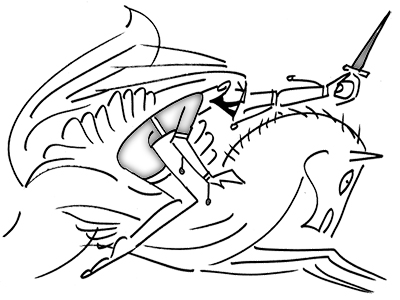Published in Devlok, Sunday Midday on March 31, 2013.
His descent will mark the end of Kali yuga. When faith is lost, when social structures collapse, when virtue is forgotten, he will be born to Sumati and Vishnuyasha. Parashuram will be his guru. He will worship Shiva. He will marry Padma and be the father of Jaya and Vijaya. He will ride a flying horse called Devadatta. He will have a parrot and a flaming sword. He will destroy the demons Kok and Vikok and overpower their master, Kali, source of all corruption, and renovate the world, heralding Satya yuga, the era of purity and joy.
This detailed description of Kalki comes from the Kalki Puran, written at least 1000 years after the Vishnu Puran dated to the Gupta Period (500 AD), where Kalki is mentioned as one of the many avatars of Vishnu, who rides a winged horse, sword in hand.
The idea of a prophesised saviour makes great sense in cultures that believe in one life. We want the end of the world to be a happy one, one where there is eternal resurrection, one who restores balance and wipes away all pollution. This is essentially the concept of messiah that is found in Judaism, Christianity and Islam. In Judaism, he is yet to come. In Christianity, he is Christ, who will return during the rapture. In Islam, he is Muhammad. Some have traced this idea of the archangel saviour, Saoshyant, of Zoroastrianism that thrived in Persia and impacted thought both in the East and the West. Indians were certainly exposed to these ideas by Mauryan times.
In Buddhism, Jainism and Hinduism, this life is but one of infinite lives. There is no end of the world, just death followed by rebirth. What goes around comes around. So the idea of a saviour does not make sense. There is nothing to save. What goes away comes back. So what is being rescued?
In biblical mythology, one needs to be rescued from misery that follows the Original Sin. In mythologies of Indian origin, one needs to be rescued from the wheel of rebirths. In one case, it is salvation. In the other, it is liberation. Influenced by ideas of the savior, Buddhists postulated the idea of the future Buddha Maitreya who comes with flaming sword when all creatures have been saved from misery. Hindus came up with the idea of Kalki.
Another reason for the origin of this idea is the fact that in the post-Buddhist period, India was overrun by many tribes from the North West who followed the Greeks: the Scythians, the Huns, the Gujars, the Kushans. They came on horseback creating the characteristic image of the saviour on a white horse. It is interesting horses are not native to India: they have always come in from the North West, via plunderers and marauders. These warriors perhaps inspired the idea of a god who wipes out the old corrupt regime and offers the possibility of a newer fresher rule.











